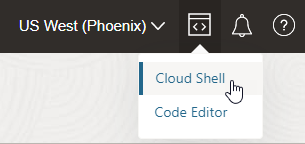Change Your Message Pack Subscription Using the Command Line
You can change the number of message packs you subscribe to using the Oracle Cloud Infrastructure command line (OCI CLI). Select a suitable number of message packs to handle the message usage you expect for your instance.
The OCI CLI is part of the Cloud Shell. The Cloud Shell provides access to a pre-installed Linux shell with a pre-authenticated OCI CLI. See Cloud Shell.
Note:
You can also edit the number of message packs through the user interface. See Edit the Edition, License Type, or Message Packs for an Instance.Message pack options are based on the type of Oracle Integration license you selected.
- For Oracle Integration:
If you created a new Oracle Integration license in the cloud:
- Each message pack includes 5,000 billing messages per hour.
- You can subscribe to up to 100 message packs.
If you brought an existing Oracle Fusion Middleware license to the cloud (BYOL):- Each message pack includes 20,000 billing messages per hour.
- You can subscribe to up to 100 message packs.
- For Oracle Integration for SaaS:
- Each message pack includes 1 million billing messages per month. Usage is tracked on a monthly basis instead of hourly, which keeps costs predictable even when you have unpredictable hourly volumes.
- You can subscribe to up to 43 message packs.
WARNING:
- You are responsible for billing based on the number of message packs you select. Select enough message packs to adequately handle your instance's activity. See Estimate Message Pack Usage for a Metered Tenancy.
- Non-production instances, for example instances for development or QA, typically need only one message pack.
- The number of message packs you subscribe to can also affect the processing time of synchronous requests. See Message Pack Usage and Synchronous/Asynchronous Requests.
- To understand how billing message usage is calculated for different features, see How Features Impact Billing Messages.
The following steps provide an example of how to increase the number of message packs for your instance. The Cloud Shell supports a variety of features, tools, and utilities. You must also grant a specific Oracle Cloud Infrastructure Identity and Access Management (IAM) policy to the user requiring access to the Cloud Shell. See Cloud Shell.
